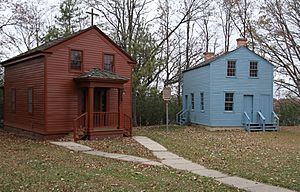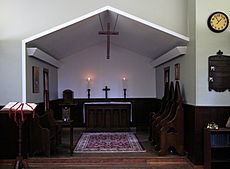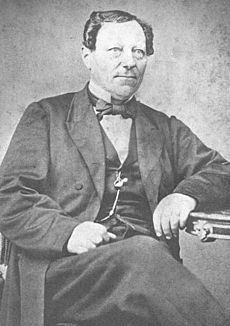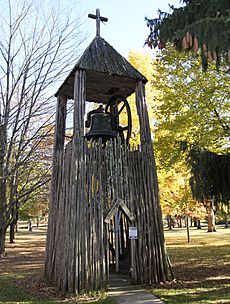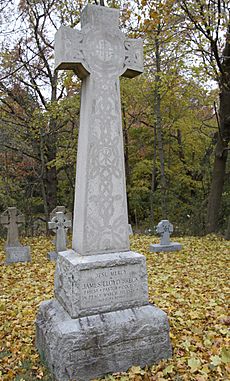Nashotah House facts for kids
 |
|
| Type | Private graduate institution |
|---|---|
| Established | 1842 |
| President | Garwood Anderson |
|
Academic staff
|
20 |
| Students | 86 |
| Location |
,
,
United States
43°4′56.5″N 88°25′33.5″W / 43.082361°N 88.425972°W |
| Campus | Rural |
| Nickname | The House, The Mission, Black Monks |
| Affiliations | Association of Theological Schools in the United States and Canada (ATS), Wisconsin Association of Independent Colleges and Universities (WAICU) |
Nashotah House is a special school in Nashotah, Wisconsin. It's a seminary, which is a college where people study to become priests or church leaders. This school follows the Anglo-Catholic tradition of Anglicanism, a type of Christianity.
The seminary first opened its doors in 1842. It officially became a chartered school in 1847. Nashotah House is an independent school. It is known for its traditional Christian teachings. It is also recognized by the Anglican Church in North America. The school's campus was added to the National Register of Historic Places in 2017. This means it's a very important historical site.
Contents
History of Nashotah House
Nashotah House was started by three young deacons from the Episcopal Church. A deacon is a church helper who is training to be a priest. These three deacons were James Lloyd Breck, William Adams, and John Henry Hobart, Jr.. They had just finished their studies at the General Theological Seminary in New York City. Bishop Jackson Kemper asked them to start this new school. Gustaf Unonius was the very first student to graduate from Nashotah House.
From the beginning, Nashotah House was a place for "High Church" ideas. This means they focused on traditional worship and practices. James Lloyd Breck, the first leader of the school, strongly believed in the ideas of the Oxford Movement. Later, famous teachers like James DeKoven brought more Anglo-Catholic worship styles to the seminary. This included celebrating the Eucharist (a special church service) every day. They also started using special clothes called vestments, candles, and incense during services.
Nashotah House sees itself as a school that teaches traditional Anglo-Catholic beliefs. The teachers generally support classic Christian ideas. They do not follow newer, more liberal ways of thinking about faith. Students who graduate from Nashotah House go on to serve in many different parts of the Anglican Church. The school's main goal is to train priests and church leaders for the entire Anglican Communion.
What Students Study
Nashotah House offers many different study programs. These programs help train clergy (church leaders) and lay leaders (people who help in the church but are not priests). They prepare students for ministries within the Anglican Communion.
Here are some of the main degrees offered:
- Doctor of Ministry (D.Min.)
- Master of Sacred Theology (S.T.M.)
- Master of Divinity (M.Div.)
- Master of Theological Studies (M.T.S.)
- Master of Arts in Ministry (M.A. in Ministry)
The school also has a one-year certificate program. This program is for students who already have a Master of Divinity degree from a non-Anglican school. It helps them learn about the Anglican tradition so they can become priests in that church. The Master of Arts in Ministry degree can be earned by studying both on campus and online. All the main degrees are officially recognized by the Association of Theological Schools in the United States and Canada (ATS).
Exploring the Campus
The Nashotah House Theological Seminary sits on a large piece of land. It covers about 365 acres, which is like 275 football fields!
Here are some of the main buildings on campus, from oldest to newest:
- The Chapel of St. Mary the Virgin was built in 1862. It was designed by James Douglas in the Gothic Revival style. This style looks like old European churches.
- Webb Hall was built in 1865. It has housing for teachers and guests. It also has the Chapel of Saints Peter and Paul. More parts were added in 1926 and 1950.
- Shelton Hall is where students live. It was built in 1869 and also has a Gothic Revival style.
- Sabine Hall has offices for teachers and more student housing. It was designed by Alexander Eschweiler in 1892 and made bigger in 1910.
- Lewis Hall was also designed by Eschweiler and built in 1892. It holds administration offices and the Saint Francis Oratory.
- The Frances Donaldson Memorial Library was built in 1911. It was designed by John B. Sutcliffe in the Collegiate Gothic style. An expansion was added in 1982.
- Kemper Hall was built in 1956. It has classrooms, student housing, and a gym.
- The James Lloyd Breck Refectory was built in 1965. This is the dining hall.
There are also apartments for students, houses for the dean and other teachers, and buildings for maintenance. A new part has been added to the refectory. This new section is called Adams Hall. It has a big meeting room and more classrooms.
Student Life
Nashotah House began as a community that lived like monks. They focused on prayer, work, and study. James Lloyd Breck wanted to create a place for Christian training in the wilderness. He hoped it would inspire other communities to spread Christianity. Today, much of this idea is still alive. Students follow a daily routine of prayer, work, and study, similar to the Benedictine Rule. The school aims to help students become more like Christ. Many students have also done mission work around the world.
Students are encouraged to grow spiritually. They practice the Benedictine Rule, which means daily prayer, labor, and study. All students have chores, like cleaning bathrooms or mowing lawns. A typical day includes Morning Prayer, Mass (a church service), breakfast, classes, lunch, and Solemn Evensong (an evening prayer service).
A fun event on campus is the annual St. Laurence Cup. This is a flag football game played against students from Sacred Heart School of Theology and St. Francis Seminary.
Famous Alumni
Many people who studied at Nashotah House have gone on to do important things. Here are some of them:
- Keith Ackerman (born 1946), a bishop
- Robert Duncan, an archbishop
- Louis Falk (born 1935), a bishop
- Richard F. Grein (born 1934), a bishop
- Daniel W. Herzog (born 1941), a bishop
- William Wallace Horstick (1902-1973), a bishop
- Benjamin Franklin Price Ivins (1884-1962), a bishop
- Russell Jacobus (born 1944), a bishop
- Charles Jenkins (born 1951), a bishop
- Christopher Kovacevich (1928–2010), a metropolitan (a high-ranking bishop)
- William Jay Lambert III, a bishop
- Jeffrey Lee, a bishop
- Charles Wesley Leffingwell (1840-1928), an editor
- Edwin M. Leidel, Jr., a provisional bishop
- William H. Love (born 1957), a bishop
- Taylor Marshall, a writer
- Esau McCaulley, an African American scholar
- John McKim (1852-1936), a bishop
- Don Moon (born 1936), a physicist and college president
- James Orin Mote (1922-2006), a bishop
- C. Wallis Ohl, Jr., a provisional bishop
- Alan M. Olson (born 1939), a philosopher
- Mark Pae (born 1926), a bishop
- William C. R. Sheridan (1917–2005), a bishop
- Dabney Tyler Smith, a bishop
- Harwood Sturtevant (1888-1977), a bishop
- Gustaf Unonius (1810-1902), a priest and author
- Reginald Heber Weller (1857-1935), a bishop
- Keith Bernard Whitmore, a bishop
- Gary Wilde (born 1952), a priest and author
- Greg Kerr-Wilson, a bishop
Notable Faculty
Many important people have also taught at Nashotah House. Here are some of them:
- Richard Fish Cadle (1796-1857), the first leader of Nashotah House
- James DeKoven (1831-1879), a faculty member
- Donald J. Parsons, (1922-2016), a professor and bishop
- Walter C. Klein, (1904-1980), a dean and bishop
- Harry Boone Porter (1923–1999), a professor and editor
- Michael Ramsey (1904-1988), an Archbishop of Canterbury and visiting professor
- Edward L. Salmon, Jr.,(1934-2016), a dean and bishop
- Arthur Anton Vogel (1924-2012), a professor and bishop
- William C. Wantland (1934), a faculty member and bishop
- William Walter Webb (1857-1933), a professor, president, and bishop


